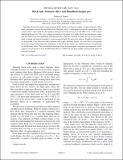| dc.contributor.author | Penna, Robert | |
| dc.date.accessioned | 2014-08-08T17:29:58Z | |
| dc.date.available | 2014-08-08T17:29:58Z | |
| dc.date.issued | 2014-05 | |
| dc.date.submitted | 2014-04 | |
| dc.identifier.issn | 1550-7998 | |
| dc.identifier.issn | 1550-2368 | |
| dc.identifier.uri | http://hdl.handle.net/1721.1/88627 | |
| dc.description.abstract | Spinning black holes tend to expel magnetic fields. In this way they are similar to superconductors. It has been a persistent concern that this black hole “Meissner effect” could quench jet power at high spins. This would make it impossible for the rapidly rotating black holes in Cyg X-1 and GRS 1915 + 105 to drive Blandford-Znajek jets. We give a simple geometrical argument why fields which become entirely radial near the horizon are not expelled by the Meissner effect and may continue to power jets up to the extremal limit. A simple and natural example is a split-monopole field. We stress that ordinary Blandford-Znajek jets are impossible if the Meissner effect operates and expels the field. Finally, we note that in our general relativistic magnetohydrodynamic simulations of black hole jets, there is no evidence that jets are quenched by the Meissner effect. The simulated jets develop a large split-monopole component spontaneously which supports our proposal for how the Meissner effect is evaded and jets from rapidly rotating black holes are powered in nature. | en_US |
| dc.description.sponsorship | MIT Department of Physics Pappalardo Program | en_US |
| dc.publisher | American Physical Society | en_US |
| dc.relation.isversionof | http://dx.doi.org/10.1103/PhysRevD.89.104057 | en_US |
| dc.rights | Article is made available in accordance with the publisher's policy and may be subject to US copyright law. Please refer to the publisher's site for terms of use. | en_US |
| dc.source | American Physical Society | en_US |
| dc.title | Black hole Meissner effect and Blandford-Znajek jets | en_US |
| dc.type | Article | en_US |
| dc.identifier.citation | Penna, Robert F. “Black Hole Meissner Effect and Blandford-Znajek Jets.” Phys. Rev. D 89, no. 10 (May 2014). © 2014 American Physical Society | en_US |
| dc.contributor.department | Massachusetts Institute of Technology. Department of Physics | en_US |
| dc.contributor.mitauthor | Penna, Robert | en_US |
| dc.relation.journal | Physical Review D | en_US |
| dc.eprint.version | Final published version | en_US |
| dc.type.uri | http://purl.org/eprint/type/JournalArticle | en_US |
| eprint.status | http://purl.org/eprint/status/PeerReviewed | en_US |
| dc.date.updated | 2014-07-23T20:48:32Z | |
| dc.language.rfc3066 | en | |
| dc.rights.holder | American Physical Society | |
| dspace.orderedauthors | Penna, Robert F. | en_US |
| dc.identifier.orcid | https://orcid.org/0000-0003-3932-6174 | |
| mit.license | PUBLISHER_POLICY | en_US |
| mit.metadata.status | Complete | |
